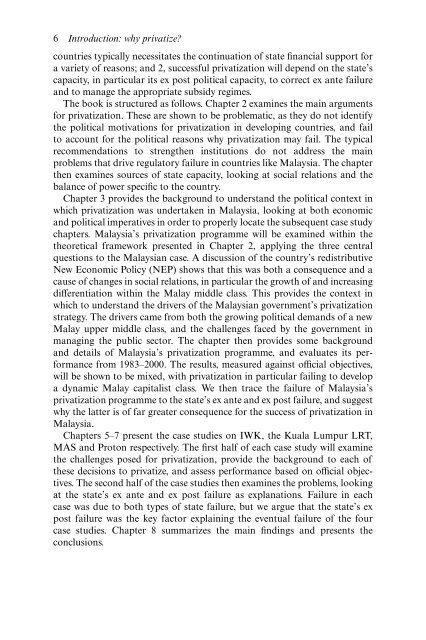PRIVATIZATION Privatization in Malaysia, Regulation, rent-seeking and policy failure
PRIVATIZATION Privatization in Malaysia, Regulation, rent-seeking and policy failure
PRIVATIZATION Privatization in Malaysia, Regulation, rent-seeking and policy failure
You also want an ePaper? Increase the reach of your titles
YUMPU automatically turns print PDFs into web optimized ePapers that Google loves.
6 Introduction: why privatize?countries typically necessitates the cont<strong>in</strong>uation of state f<strong>in</strong>ancial support fora variety of reasons; <strong>and</strong> 2, successful privatization will depend on the state’scapacity, <strong>in</strong> particular its ex post political capacity, to correct ex ante <strong>failure</strong><strong>and</strong> to manage the appropriate subsidy regimes.The book is structured as follows. Chapter 2 exam<strong>in</strong>es the ma<strong>in</strong> argumentsfor privatization. These are shown to be problematic, as they do not identifythe political motivations for privatization <strong>in</strong> develop<strong>in</strong>g countries, <strong>and</strong> failto account for the political reasons why privatization may fail. The typicalrecommendations to strengthen <strong>in</strong>stitutions do not address the ma<strong>in</strong>problems that drive regulatory <strong>failure</strong> <strong>in</strong> countries like <strong>Malaysia</strong>. The chapterthen exam<strong>in</strong>es sources of state capacity, look<strong>in</strong>g at social relations <strong>and</strong> thebalance of power specific to the country.Chapter 3 provides the background to underst<strong>and</strong> the political context <strong>in</strong>which privatization was undertaken <strong>in</strong> <strong>Malaysia</strong>, look<strong>in</strong>g at both economic<strong>and</strong> political imperatives <strong>in</strong> order to properly locate the subsequent case studychapters. <strong>Malaysia</strong>’s privatization programme will be exam<strong>in</strong>ed with<strong>in</strong> thetheoretical framework presented <strong>in</strong> Chapter 2, apply<strong>in</strong>g the three centralquestions to the <strong>Malaysia</strong>n case. A discussion of the country’s redistributiveNew Economic Policy (NEP) shows that this was both a consequence <strong>and</strong> acause of changes <strong>in</strong> social relations, <strong>in</strong> particular the growth of <strong>and</strong> <strong>in</strong>creas<strong>in</strong>gdiffe<strong>rent</strong>iation with<strong>in</strong> the Malay middle class. This provides the context <strong>in</strong>which to underst<strong>and</strong> the drivers of the <strong>Malaysia</strong>n government’s privatizationstrategy. The drivers came from both the grow<strong>in</strong>g political dem<strong>and</strong>s of a newMalay upper middle class, <strong>and</strong> the challenges faced by the government <strong>in</strong>manag<strong>in</strong>g the public sector. The chapter then provides some background<strong>and</strong> details of <strong>Malaysia</strong>’s privatization programme, <strong>and</strong> evaluates its performancefrom 1983–2000. The results, measured aga<strong>in</strong>st official objectives,will be shown to be mixed, with privatization <strong>in</strong> particular fail<strong>in</strong>g to developa dynamic Malay capitalist class. We then trace the <strong>failure</strong> of <strong>Malaysia</strong>’sprivatization programme to the state’s ex ante <strong>and</strong> ex post <strong>failure</strong>, <strong>and</strong> suggestwhy the latter is of far greater consequence for the success of privatization <strong>in</strong><strong>Malaysia</strong>.Chapters 5–7 present the case studies on IWK, the Kuala Lumpur LRT,MAS <strong>and</strong> Proton respectively. The first half of each case study will exam<strong>in</strong>ethe challenges posed for privatization, provide the background to each ofthese decisions to privatize, <strong>and</strong> assess performance based on official objectives.The second half of the case studies then exam<strong>in</strong>es the problems, look<strong>in</strong>gat the state’s ex ante <strong>and</strong> ex post <strong>failure</strong> as explanations. Failure <strong>in</strong> eachcase was due to both types of state <strong>failure</strong>, but we argue that the state’s expost <strong>failure</strong> was the key factor expla<strong>in</strong><strong>in</strong>g the eventual <strong>failure</strong> of the fourcase studies. Chapter 8 summarizes the ma<strong>in</strong> f<strong>in</strong>d<strong>in</strong>gs <strong>and</strong> presents theconclusions.


